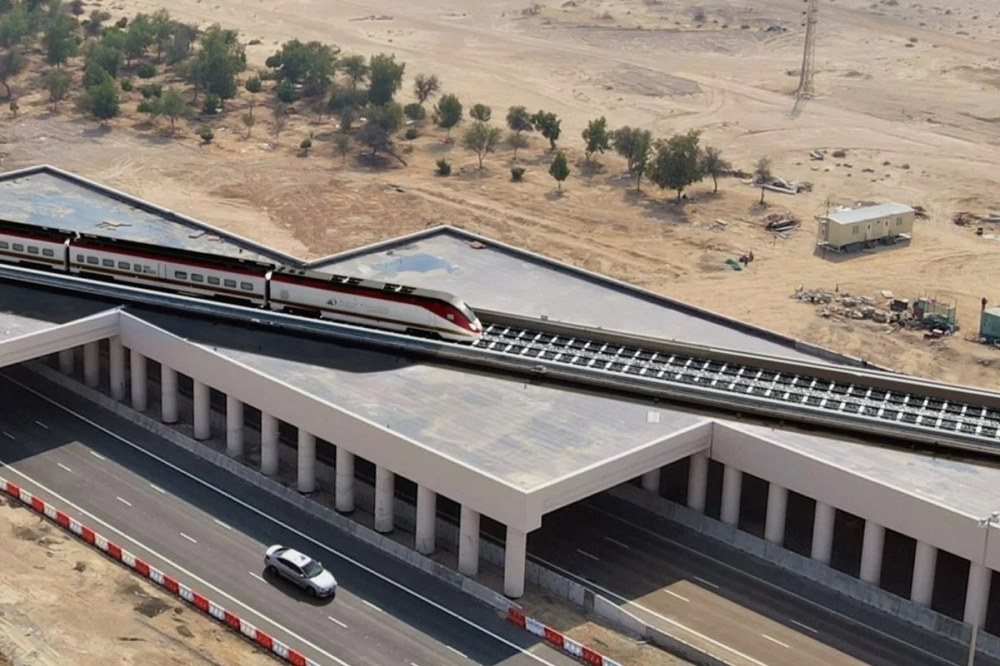A new US$3 billion railway, named Hafeet Rail, stretching from the UAE to Oman has been approved. The Oman Rail, Etihad Rail and Mubadala Investment Company unanimously gave the green light for the project earlier this week. The project is expected to boost UAE and Oman ass gateways to regional markets whilst stimulating the economy of both countries. Approval was given during Sultan Haitham bin Tarik’s state visit to the UAE. This facilitated the significant partnership between the two countries through the signed agreement. Sheikh Theyab bin Mohamed bin Zayed Al Nahyan, Deputy Chairman of the Presidential Court for Development and Fallen Heroes’ Affairs, and Chairman of Etihad Rail was also present for the signing ceremony.
Goals for the UAE, Oman Hafeet Rail System
Goals for Hafeet Rail line include enhancing cross-border connectivity and catalysing economic growth. Another major goal is job creation across diverse sectors in both countries. The project that connects the commercial ports to the rail network of both countries would make cross-border trade both efficient and easy.
The Hafeet Rail network will easily connect commercial ports to railway infrastructure. This will allow for cargo transportation, with a single goods train capable of hauling more than 15,000 metric tonnes of goods. This is equivalent to 270 conventional containers. The system is intended to have a favourable influence on the iron and steel, mining, and petrochemical industries. Agriculture and food are also included, as well as retail and e-commerce.
Furthermore, the passenger rail services will serve to connect population centres. This will foster social and familial cohesion while supporting the tourism sector. Travellers between the two countries enjoying an easy and smooth travel experience thanks to innovative solutions. The passenger train can reach speeds of up to 200kmph. It covers the distance between Sohar and Abu Dhabi in 100 minutes. Moreover, Sohar and Al Ain will only be 47 minutes away. The one train can accommodate up to 400 passengers.
Also Read: Construction Commences on the Mega $17 Billion Iron Ore Rail-and-Port Scheme in Guinea
Abdulrahman Al Hatmi, Chief Executive Officer of Asyad Group, highlighted the role of the project in reaffirming the strategic logistical hubs for import and distribution of good to regional and global markets in Oman and the UAE. This is in light of the current economic boom in the neighbouring countries and in the GCC. He also commended the strategic vision and economic foresight of Oman and the UAE. They are both aiming to foster an integrated transportation ecosystem that will reshape the logistics landscape in the region.

Origin of the Hafeet Rail name
The name of the system is drawn from Jebel Hafeet, a region that stretches between the Sultanate of Oman and the UAE. The region holds strategic significance and historical importance for both countries. It serves as a link between the two neighbours through its rugged terrain. Mountains, deserts, and unique limestone formations are all features of the region. It rises1,249 metres above sea level. Furthermore, the numerous picturesque natural landmarks have long captivated citizens and tourists alike from across the globe.
The President of Oman Investment Authority, Abdulsalam bin Mohammed stated that the joint railway network is a significant addition to the logistics sector. It will play a role in stimulating various industrial sectors and economic activities. The network also increases commercial and investment opportunities for the private sector and supports the integration of Omani port activities and linking them to regional and international markets. All this is in addition to its contribution to attracting national and foreign investments.

